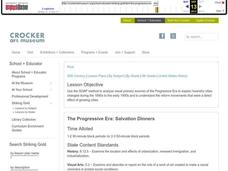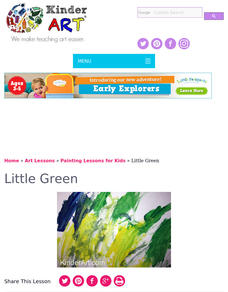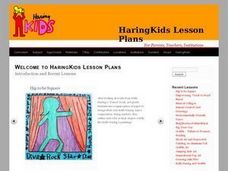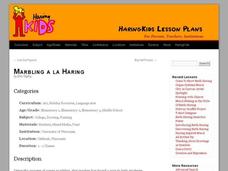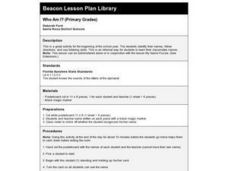Stanford University
Voices of the Struggle: The Continual Struggle for Equality
As part of a study of the Civil Rights Movement from 1868 to the present, class members examine first person narratives, the Supreme Court case Brown v. Board of Education, and other significant events in civil rights history....
Curated OER
The Progressive Era
Eighth graders utilize the SOAP method to analyze a work of art and relate it to what they know about the Progressive Era and the reasons why cities changed and the ways in which cities changed during the end of the 19th century. They...
Curated OER
ABC and 1-2-3 Farming
Students demonstrate how to alphabetize animal names. In this word study activity, students identify animals that live on the farm and conduct a favorite farm animal survey. Students order animal pictures in alphabetical order.
Alabama Department of Archives and History
Alabama Farm Life in the Great Depression
The Great Depression not only impacted city folk and factory workers, it also had a profound effect on farmers. Young historians examine primary source materials that document the struggles of Alabama farmers during this time and...
Curated OER
"Old 300"
Fourth graders combine art and history to assess the importance of the "Old 300." They explore a group of colonists that Stephen F. Austin brought to Texas as the first settlers and then create a time line of major events leading to the...
Curated OER
Oklahoma! The Cultural Myth of America
Learners explore cultural myths in America by collecting images and characteristics of stereotypical Americans. They read a primary source document, discussing the views of the author in class. Next, they compare the terms used to...
Alabama Learning Exchange
Ice Fishing is for the Birds
Approach addition with young mathematicians in an engaging way through this penguin-inspired activity. In small groups, scholars think about times they have used addition in their real lives (there are some suggestions given), then watch...
Curated OER
Fracking: Positive or Negative Impact?
Your teenagers may have heard of fracking, but do they really know what it is? And could they debate the benefits and risks? Educate your environmental science class with a lesson about hydraulic fracturing, non-renewable energy...
National Woman's History Museum
Women, Propaganda, and War
Governments rely on propaganda to build support for wars. Class members examine six propaganda posters, two each from the Spanish-American War, World War I, and World War II, and analyze how the way women were portrayed in the posters...
Curated OER
Call to Arms: A Service Project
Sick of selling candy and washing cars? How about hosting a Digital Day or a Learning Lunch? The suggestions here make fund raising fun and rewarding. Raise money to preserve important maps and other primary source documents.
Curated OER
Mondrian, Math, and Amazing Colors
Learners study geometric shapes, lines, and the primary colors as they create Mondrian-like art prints.
Curated OER
Easter Egg Eggstravaganza
Students identify functions and proper use of the computer. They identify secondary colors by mixing primary colors. Students reinforce listening, speaking and following directions by playing a game. They identify the color gold.
Curated OER
Little Green
Young scholars explore how to make the color green by mixing the two primary colors, blue and yellow.
Curated OER
Mastering the Document-Based Essay Question
Students use a primary source document from the Civil War period of history in order to derive meaning for an essay question. The essay is based completely on the document with no other research to support the content.
Curated OER
Report Writing in Primary Grades
Young scholars learn how to read a short section and parepare a sentence to share with the group. Students listen to the reading of expository text, restate, in sentence format, one fact learned from that text, and produce a report.
Curated OER
What We Leave Behind
Learners analyze primary source documents from the 1830's. They examine how records, memoirs and artifacts preserve history and discuss what should be placed in a time capsule for future generations.
Curated OER
Studying Japanese Internment with Primary Documents
Eleventh graders view photographs of the Japanese society being interned in camps during World War II in the United States. In groups, they read and discuss Executive Order 9066 and try to determine what group they are trying to focus...
Curated OER
Mixing Up Magic
Pupils explore the relationship between art and science through experimenting with color, design and recycled materials and creating their own art work.
Curated OER
Lesson on Wayne Thiebaud
Fourth graders view Theibaud's work in order to form opinions and share in class discussions. They also critique some of the artists work using the Linderman method and recreate the artist's style of work with their own paintings.
Curated OER
Marbling A La Haring
Students create a paper marbling painting based on the work done by Keith Haring. In this paper marbling lesson plan, students create abstract compositions and create a small mural with one another of their interlocking shapes.
Curated OER
Who Am I? (Primary Grades)
Students identify their names, follow directions and use listening skills to learn their classmates names in a game format.
Curated OER
Mark Twain's Hannibal
Students research life in Hannibal, Missouri. In this Mark Twain lesson, students analyze primary sources to develop an understanding of life in Hannibal in the late 19th century. This lesson may be used as an introduction to Twain's...
Curated OER
The Minerva Mosaic of the Library of Congress
Students analyze the Minerva mosaic. In this Library of Congress lesson, students conduct primary source analysis of the mosaic as they interpret the symbolism and mythology featured in the mosaic.
Curated OER
Piecing Together the Story of Glenn Cunningham: A Kansas Champion
Students use primary and secondary sources to conduct research about Glenn Cunningham. In this Glenn Cunningham lesson plan, students tell why he was a hero, and tell facts from what they learned.
Other popular searches
- Art Lessons Primary Penguins
- Edible Art Lessons Primary
- Art Lessons Primary Easter
- 3d Art Lessons Primary
- Art Lessons Primary Fruit
- Winter Art Lessons Primary
- Maori Art Lessons Primary
- Visual Art Lessons Primary
- Art Lessons Primary Tiger
- Art Lessons Primary Water
- Art Lessons Primary Victoria
- Art Lessons Primary Art



